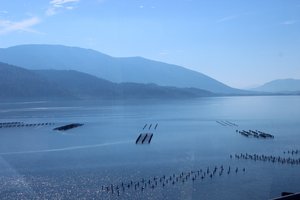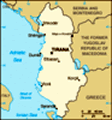Advertisement
Published: October 2nd 2016

 Mussel farms
Mussel farms
Sarande, AlbaniaWe wake up this morning with the ship in the process of anchoring off Sarande, Albania. Our first port of call was supposed to be Ephesus, Turkey, but the political unrest in that country prompted Holland America to switch to Sarande.
Sarande is actually just across the bay from Corfu, Greece. The town (and Albania as a whole) is still transitioning to a democracy from the tight-fisted communist rule that ended in 1990. Sarande would dearly love to become the next Corfu. It boasts a rich cultural history and beautiful beaches and natural settings. What is lacking are the facilities and culture shift needed to support rich North American tourists such as ourselves in the style to which we are accustomed.
We have selected a tour that focuses on the archeological history of the area. After tendering from the ship to shore, we meet our local guide, Linda, and hop on the bus. Our destination is an area called Butrint, which is a Unesco Heritage Site. We drive out of Sarande, climbing all the while. On the other side of the mountains lies an extensive salt-water lake where mussels are cultivated. Butrint lies on a peninsula of the lake
with water mostly around it, so historically it offered good defensibility.
There are five historical periods revealed in the ruins around Butrint: Hellenic (Greek), early Roman, late Roman (Byzantine), medieval, and Venetian. As is often the case, one civilization built upon the previous, so the further down you dig, the older the ruins. Linda walks us through the various sets of ruins, explaining what the structures were used for at various periods in history.
Particularly impressive is an amphitheatre, originally built by the Greeks but later expanded by the Romans. Linda tells us that it is still used on special occasions for musical and theatrical presentations and still has excellent acoustics. There are two Roman baths, one large (probably public) and one small (probably private). Each comprises a vestibulium, where one undresses, the bath room where hot water and steam rise from pipes in the floor, and a fridgidarium, where one cools off. Also impressive are two Byzantine buildings: a baptistery and a church. The baptistery has one of the best-preserved mosaic floors from that era in the world, although we can only look at a photo right now because it is covered with sand to protect it.
The church has massive walls outlining a cross pattern that have somehow survived erosion and earthquakes over the centuries.
We then start climbing. Some of the steps are centuries or even millennia old, and some are modern. The common theme is: highly uneven. Along the way we see the remains of the Roman aqueduct, which collapsed in an earthquake, and several gigantic defensive walls with guarded gates for entry. At the top is a Venetian-era castle that has been turned into a museum to showcase some of the discoveries unearthed in the area.
We descend by a different path to our bus and return to Sarande, where we disembark and stroll along the broad beachside promenade, typical of what you find in many Mediterranean cities. You can easily imagine yourself on the Riviera; all you would need is some annoying pedlars.
I take this opportunity to ask Linda some questions. I have noticed quite a few high-end cars here, particularly Mercedes-Benz, something that surprised me a bit. Linda explains that luxury autos are a status symbol in Albania, but no one can afford them new. The ones I see are all second-hand, imported from other parts of
Europe. Linda also clears up another point. I have heard more than once than Albanians shake their heads to mean "no" and nod their heads to say "yes," the opposite of what most of cultures. Linda tells me this is not really true. The confusion arises because inclining one's head left and right without turning the head means "yes," which is easily interpreted by foreigners as "no." Shaking the head still means "no."
For the final stop on our tour, we climb a few blocks away from the ocean to reach the low remains of a Jewish Synagogue in the centre of the city that served that community for hundreds of years. A final ride on the bus back to the peer and a tender ride back to the ship.
Supper table luck of the draw tonight is two couples from Chicago and a couple from near Melbourne, Australia. We spent a bit of time in the piano bar, then head for bed. By this time, the ship has already reached the Greek island of Corfu.
Advertisement
Tot: 0.101s; Tpl: 0.029s; cc: 13; qc: 28; dbt: 0.0544s; 1; m:domysql w:travelblog (10.17.0.13); sld: 1;
; mem: 1.1mb










